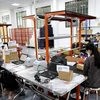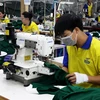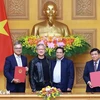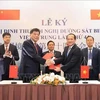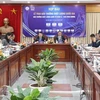Southern Vietnamese provinces and cities have made great economic strides over the last four decades since the region’s liberation and the national reunification in 1975, substantially contributing to Vietnam’s development.
An array of industrial hubs have been created in the south, which used to house only small-scale mechanical industry mainly serving military purposes, said Vice Chairman of the National Assembly’s Committee for Economic Affairs Nguyen Duc Kien.
Ho Chi Minh City, formerly known as Saigon, is now an economic, cultural, and scientific-technological hub of Vietnam and the nucleus of the southern key economic region. It contributes about one fifth of the national GDP and one third of the State budget every year.
Ba Ria-Vung Tau province, which used to be an underdeveloped area, currently accommodates an oil and gas industrial park along with the largest maritime service cluster of Vietnam.
Binh Duong province has followed a similar path, becoming a modern industrial locality following its ‘doi moi’ (renewal) efforts and the country’s international economic integration.
With agricultural advantages, southwestern provinces have helped ensure food security and contributed to the nation’s export of 6 million tonnes of rice and 8 billion USD worth of aquatic products each year.
The southern key economic region, the biggest of its kind in Vietnam, consists of HCM City and the provinces of Dong Nai, Ba Ria-Vung Tau, Binh Duong, Binh Phuoc, Tay Ninh, Long An, and Tien Giang.
The General Statistics Office said this region accounts for some 17 percent of population and more than 8 percent of total area of Vietnam. Its production makes up 42 percent of the national GDP and nearly 40 percent of export revenue. The region contributes some 60 percent to the State budget.
Under a master plan approved by Prime Minister Nguyen Tan Dung in early 2014, the economic region’s industry, construction, and service sectors will constitute 95-96 percent of its GDP with services making up 44 percent by 2020.
Average per capita GDP will reach up to 4,000 USD in 2015 and exceed 5,000 USD by 2020. Meanwhile, per capita export value is expected to increase to 3,700 USD and 5,400 USD, respectively.
By 2030, the region is set to be a role model of sustainable development with an advanced knowledge economy. It will also become an economic hub of Asia and a global commercial, financial and service centre.
To realise these ambitious goals, the regional localities need to speed up economic restructuring with a focus on improving productivity, product quality, and business competitiveness, said To Dinh Tuan, Editor in Chief of the HCM City Party Committee’s website.
They should develop infrastructure and high-quality human resources, a better business climate and attract more foreign direct investment in fields that they have advantages in, he added, noting that they must ensure good connectivity within the region and with localities outside.
Regarding HCM City, Chairman of the Party Central Committee’s Commission for Economic Affairs, Vuong Dinh Hue, said the city needs to strive for more rapid and sustainable economic growth.
He pointed out problems facing the city, including enterprises’ low competitiveness and the disparity between infrastructure development and economic growth rate and living conditions.
Holding a pivotal role, HCM City is able to guide the development of the southern key economic region, which in turn will be a powerful driver of the south and Vietnam as a whole, Hue noted.-VNA
An array of industrial hubs have been created in the south, which used to house only small-scale mechanical industry mainly serving military purposes, said Vice Chairman of the National Assembly’s Committee for Economic Affairs Nguyen Duc Kien.
Ho Chi Minh City, formerly known as Saigon, is now an economic, cultural, and scientific-technological hub of Vietnam and the nucleus of the southern key economic region. It contributes about one fifth of the national GDP and one third of the State budget every year.
Ba Ria-Vung Tau province, which used to be an underdeveloped area, currently accommodates an oil and gas industrial park along with the largest maritime service cluster of Vietnam.
Binh Duong province has followed a similar path, becoming a modern industrial locality following its ‘doi moi’ (renewal) efforts and the country’s international economic integration.
With agricultural advantages, southwestern provinces have helped ensure food security and contributed to the nation’s export of 6 million tonnes of rice and 8 billion USD worth of aquatic products each year.
The southern key economic region, the biggest of its kind in Vietnam, consists of HCM City and the provinces of Dong Nai, Ba Ria-Vung Tau, Binh Duong, Binh Phuoc, Tay Ninh, Long An, and Tien Giang.
The General Statistics Office said this region accounts for some 17 percent of population and more than 8 percent of total area of Vietnam. Its production makes up 42 percent of the national GDP and nearly 40 percent of export revenue. The region contributes some 60 percent to the State budget.
Under a master plan approved by Prime Minister Nguyen Tan Dung in early 2014, the economic region’s industry, construction, and service sectors will constitute 95-96 percent of its GDP with services making up 44 percent by 2020.
Average per capita GDP will reach up to 4,000 USD in 2015 and exceed 5,000 USD by 2020. Meanwhile, per capita export value is expected to increase to 3,700 USD and 5,400 USD, respectively.
By 2030, the region is set to be a role model of sustainable development with an advanced knowledge economy. It will also become an economic hub of Asia and a global commercial, financial and service centre.
To realise these ambitious goals, the regional localities need to speed up economic restructuring with a focus on improving productivity, product quality, and business competitiveness, said To Dinh Tuan, Editor in Chief of the HCM City Party Committee’s website.
They should develop infrastructure and high-quality human resources, a better business climate and attract more foreign direct investment in fields that they have advantages in, he added, noting that they must ensure good connectivity within the region and with localities outside.
Regarding HCM City, Chairman of the Party Central Committee’s Commission for Economic Affairs, Vuong Dinh Hue, said the city needs to strive for more rapid and sustainable economic growth.
He pointed out problems facing the city, including enterprises’ low competitiveness and the disparity between infrastructure development and economic growth rate and living conditions.
Holding a pivotal role, HCM City is able to guide the development of the southern key economic region, which in turn will be a powerful driver of the south and Vietnam as a whole, Hue noted.-VNA








